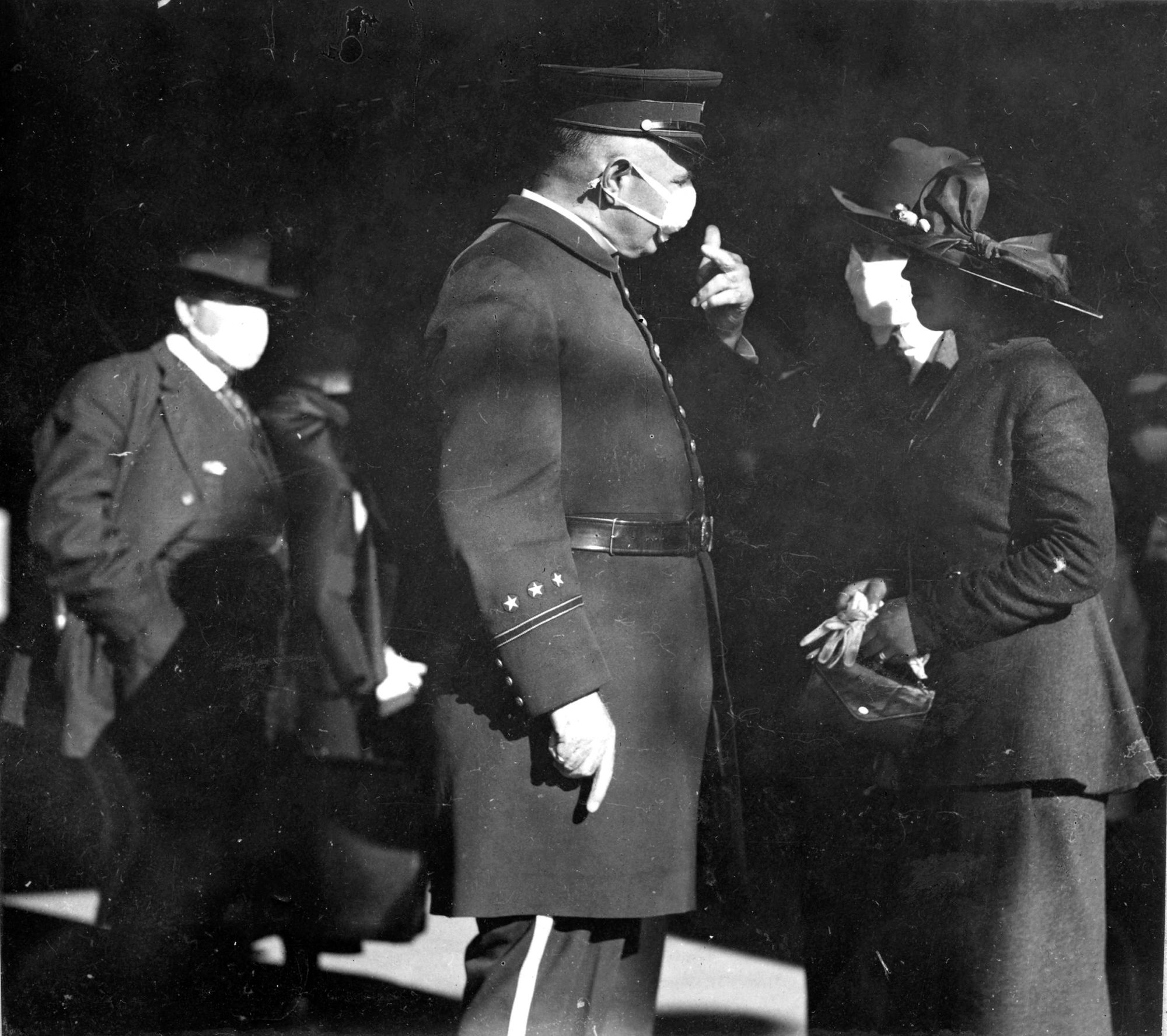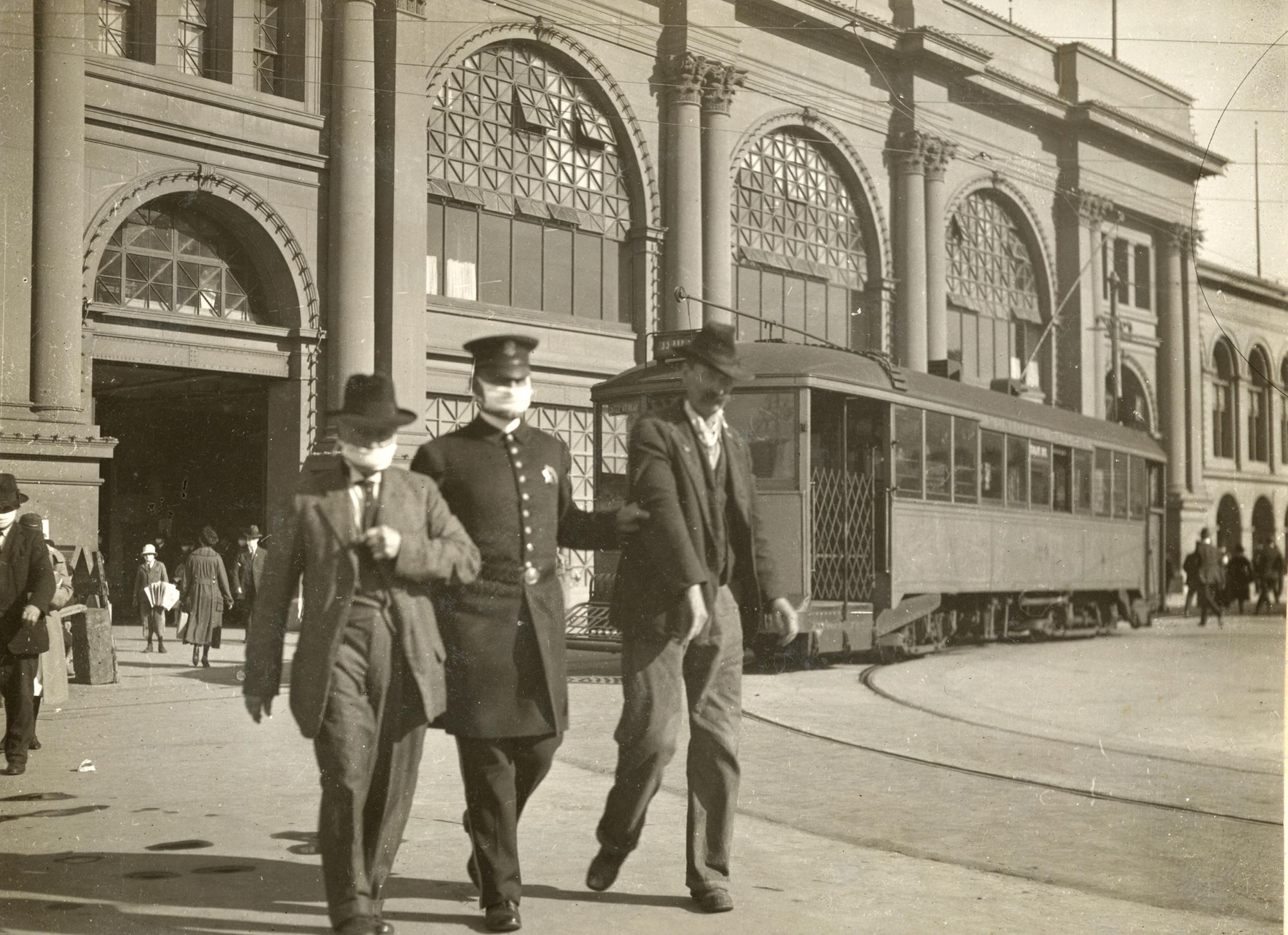Way back in April, when we were all relative newbs to this pandemic business, SFist published a post about anti-maskers — specifically, the fools in San Francisco in 1918 whom we could look back upon and scoff at because they quickly grew tired of wearing masks in public to stop the spread of that 102-year-old influenza pandemic.
Now as we're at least ankle-deep in a growing surge of cases — California is knee-deep with a record 20,654 new cases added on Monday, and much of the rest of the country is in more dire straights — it's time to revisit the story of the 1918 pandemic here in the Bay Area, in case you missed it. San Franciscans feeling pandemic fatigue and getting lackadaisical about mask-wearing as they invite people over for dinner and gather with friends across tables at outdoor bars, etc., need to understand: You are the problem.
SF Public Health officials noted via the Chronicle on Monday that between October 21 and November 10, the demographics of new cases took a notable turn — with more people between ages 18 and 30 and more people living in affluent parts of the city — becoming infected than at any point since March. Some of that may be from social gatherings, some of that may be from travel — I'm seeing a lot of people bouncing to and from Mexico in Instagram Stories — and some of that may be from dining indoors with masks off. And yes, essential workers are still getting infected.
So let's look back at 1918 again. SF had a Fauci-esque man of science in the role of Director of Public Health, Dr. William C. Hassler, and he got the Board of Supervisors to institute a mask-wearing ordinance in October 1918 just as influenza cases began surging in the city for the first time — the city had mostly avoided the first wave of the pandemic the previous winter, but it traveled from east to west.

Local case counts went down by mid-November, and around Thanksgiving, on November 21, the mask order was lifted, prompting much jubilation around the city after only a month of mandatory masking, with masks being tossed out into the streets.
As the Chronicle put it at the time, "After four weeks of muzzled misery, San Francisco unmasked at noon yesterday and ventured to draw its breath. Despite the published prayers of the Health Department for conservation of gauze, the sidewalks and runnels were strewn with the relics of a torturous month."

But it was just a matter of weeks before the flu came steamrolling back through the city, quickly overwhelming hospitals by Christmas and New Year's.
"The dollar sign is exalted above the health sign," Dr. Hassler lamented at the time, regarding the lifting of the mask order — which the Board of Supervisors didn't re-institute until January 10, when the city was seeing 600 new cases per day. "When the masks were removed [in November], only 10 cases a day were being reported," Hassler said in a report to the public. "Nine days later the daily total was reaching 75. And it has increased ever since until now we have had well over 200 [per day] for several days."
San Francisco's death toll from 1918 pandemic nearly doubled in January 1919, and still there was an "Anti-Mask League" that hosted a rally in mid-January that reportedly drew 2,000 attendees.
Mayor James “Sunny Jim” Rolph was among the mask-averse, and was himself fined $50 for flouting the mask order and showing up at a boxing match unmasked. And when the flu resurged in December and January, Rolph was on the record blaming "persons coming here from other cities" for bringing the virus back to San Francisco after the city had "successfully stamped it out."

Because of attitudes like this, and perhaps because of San Francisco's longstanding reputation as a boozy party town, it was one of the hardest-hit American cities in the 1918/1919 pandemic. By one estimate cited by local historian Gary Kamiya, 45,000 San Franciscans were infected and over 3,000 died — a mortality rate of 7%, well above the national average of 2.5%. Another estimate suggests 3,500 died of the flu in San Francisco, many of them in the winter months following the December surge.
Thankfully, San Francisco's politics — and the unfortunate politicization of mask-wearing — has swung the other direction, and people aren't so publicly derisive of mask mandates here during this pandemic. But people are getting lazy — and a quick walk through Civic Center or the Tenderloin will provide you with plenty of evidence that not everyone is listening or concerned about getting infected, and plenty of people are gathering unmasked at all hours.
A half-million Americans died of the flu between 1918 and 1920, before the virus mysteriously lost its potency and mutated into the less severe flu we typically see every year.

With over 258,000 Americans now dead from COVID-19, this pandemic is likely to top the 1918 one in total deaths — especially since we are only about three weeks into an exponential surge across the country.
Here in the Bay Area, unless something shifts and people stay home more in the next few weeks, we'll be looking at a repeat of January 1919, with overwhelmed hospitals and a mortality rate that's no longer among the lowest in the country. The number of people in Bay Area hospitals with severe COVID cases was 667 as of Monday, more than double the number that were hospitalized when the last surge began in late June, and almost double the number from one month ago.
Stay vigilant!! Don't throw little dinner parties!! Keep your Thanksgivings small and preferably outdoors!! And quarantine yourself for two weeks if you've been out doing things you shouldn't be doing!!
Previously: History Lesson: SF Had an Anti-Mask League During the 1918 Flu Pandemic Who Rallied Against Face Masks
Top image: San Franciscans lining up for masks. Photo: California State Library via the California Sun

